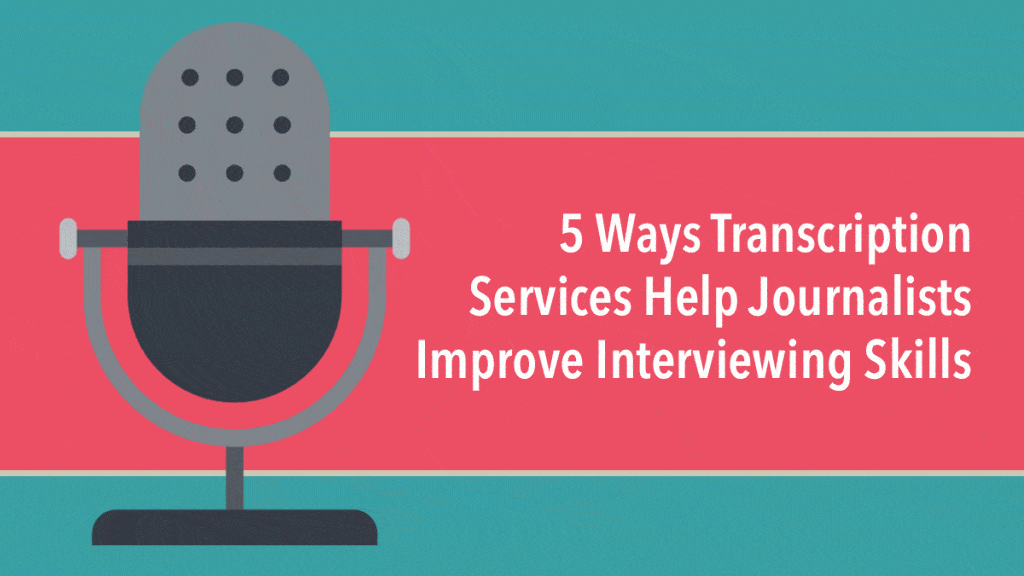5 Ways Transcription Services Can Help Journalists Improve Their Interviewing Skills

Rev › Blog › Transcription Blog ›
The following post was written by one of our Revvers from New York who has been with us as transcriptionist since October 2016.
As a journalist, are you too talkative during your interviews or perhaps not engaging enough? Are the questions you’re asking unclear? You may be oblivious to some of the common mistakes you’re making as an interviewer, but seeing your interviews in written form can help shed some light on your weaknesses. One of the easiest ways to turn your interview audio into text is to use an online transcription service. Once you have your transcript in hand, you should ask yourself the following questions:
1. Are you too robotic?
When reviewing your transcript, are you engaging with the interviewee, or are you jumping right to the next question without acknowledging their response? When you delve deeper into your subject’s responses, not only are you subtly reminding them that you’re actively listening, you’re also stimulating new paths of discussion.
The questions that you’ve prepared for the interview should not be set in stone. They should simply serve as a rough guide to keep the interview focused.
2. Are you interrupting your interviewee?
Some journalists, in their effort to engage with their interviewees, end up being a little too enthusiastic for their own good. Let’s say you’re interviewing a subject named Bob, and your exchange looks something like this:
Bob: I worked there for about a decade now and-
You: No way! Really? A decade?
Bob: …I’ve gained so much experience and wisdom that-
You: Oh I bet!
Bob: Yeah, I know it’s been a wonderful journey, and [crosstalk 01:08:35] couldn’t be more grateful.
Poor Bob can’t get a word in. If you’ve got too many hyphens, ellipses, and “crosstalk” tags (which in this case represents interruptions) in your transcript, this is a sign you’re disrupting your interviewee’s speech flow. While not intentional, this may be viewed as rude, and you’ll find that your interviewee’s responses were left unfinished because your interjections threw them off track. You’ll either have to contact them again to get their full response or simply deal with an abbreviated quote for your article. Both are undesirable outcomes that are completely avoidable.
3. Are you allowing awkward pauses?
On the flip side, just as a journalist needs to know when to zip their lips, they also need to know when to steer the interview. Long pauses typically signal that the interviewee is waiting for you to take control of the conversation. You can avoid awkward pauses by listening carefully to your interviewee’s response while also formulating questions in your mind to follow up with once they’ve finished speaking. This helps you to avoid digging through your notes or racking your brain for a question while your interviewee waits in silence.
4. Are your questions clear and concise?
Some journalists have a tendency to ask more than one question at a time, causing confusion for the person they’re interviewing. While reading your transcript, if you notice that the interviewee asks for further clarification or for you to repeat questions, work on being more clear and concise.
Watch out for clunky, confusing questions like this one:
You: What was the main motivator that drove you to become the person we know today? Who was your role model and what advice would you give others if they wanted to follow in your footsteps?
Bob: Sorry, could you repeat the question again?
5. Are you articulate?
When you’re conducting a professional interview, you should avoid filler words and colloquialisms that occur in casual conversations such as “like” and “you know what I mean.” A verbatim transcript is a perfect tool for seeing how frequently you use these words or phrases since most of us are oblivious to our own everyday speech habits. When ordering a transcript, Rev provides a verbatim option which means all filler words such as “ah,” “um,” and “well” will be included. Once you have your transcript, simply browse through it or use the “search” option in Microsoft Word to quickly find particular words or phrases.
Do you have ideas on how journalists can improve their interviews by using a transcription service? We’d love to hear from you in the comments section below!
